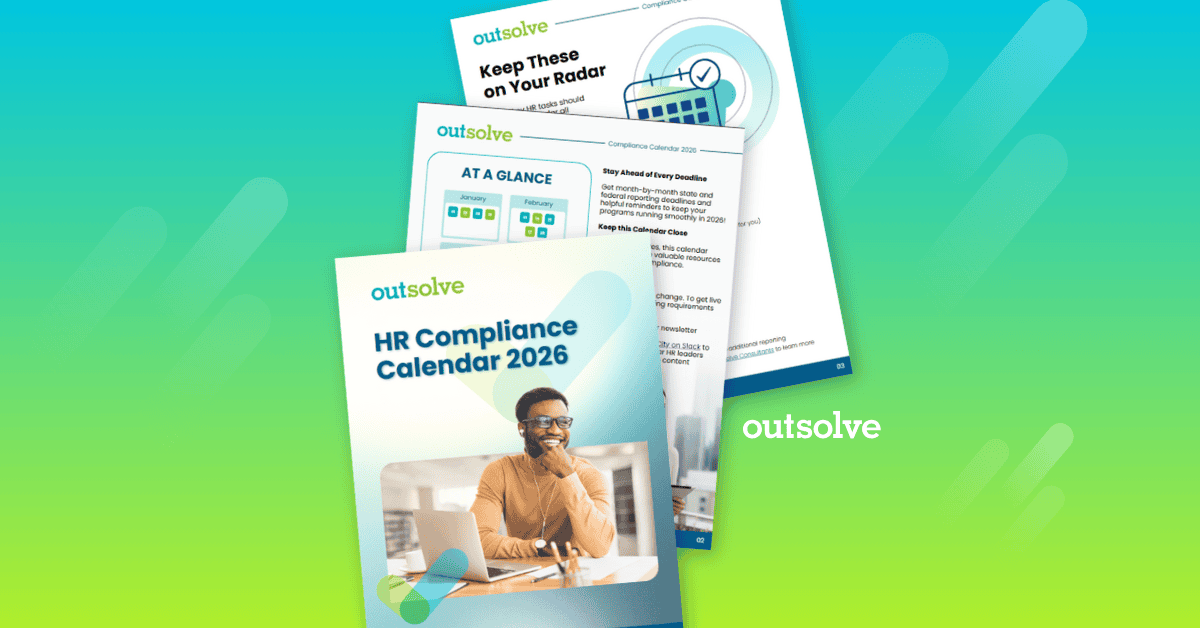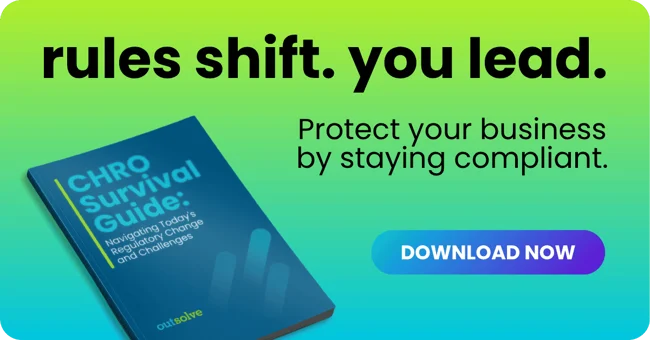5 min read
CHRO Survival Guide: Talent, Culture, and Leadership: How CHROs Can Thrive in Uncertain Times
![]() OutSolve
:
Nov 19, 2025 2:16:05 PM
OutSolve
:
Nov 19, 2025 2:16:05 PM

In Part 2 of our CHRO Survival Guide series, we explored the costs of deregulation, the intensity of I-9 and E-Verify enforcement, and the impact of AI on HR compliance. In this final installment, Part 3 turns to the human side of HR leadership. We’ll examine how CHROs are navigating talent shortages, balancing automation with personalization in hiring, and responding to growing employee expectations around wellbeing and flexibility.
We’ll also explore how organizations can reconcile their corporate culture with shifting regulatory directives, and why trust, transparency, and adaptability are now the defining qualities of successful HR leadership.
Talent Acquisition and Retention
The talent acquisition landscape has fundamentally shifted, creating challenges that require CHROs to rethink their approach to finding and attracting candidates. There is perhaps a perfect storm of influences: skill shortages in key industries, evolving candidate expectations, and technological capabilities that can either enhance or undermine the human connection that's essential to successful recruitment.
There are several factors impacting talent recruitment today. Among them are:
- Over-automation — Candidate engagement tools powered by AI can speed sourcing but risk alienating applicants if interactions feel impersonal. Candidates increasingly report that generic automated messages feel dismissive, reducing interest in the role.
- Multi-stage interview fatigue — Lengthy hiring processes are causing candidate drop-off, particularly among in-demand talent who may have multiple offers.
- Remote and hybrid logistics — Virtual interviews have widened talent pools but require robust scheduling systems and clear communication to keep candidates engaged.
The speed-to-hire imperative has intensified dramatically. In competitive markets, qualified candidates often receive multiple offers within days of beginning their job search. Companies with lengthy interview processes are losing top candidates to competitors who can move more quickly. But accelerating the hiring process without compromising quality requires sophisticated screening tools and well-trained interview teams.
Retention Pressures
In addition to pay (often the top driver), retention is now closely tied to employee experience, mental health resources, and flexibility. A 2024 Gallup study found that employees who strongly agree their employer cares about their wellbeing are 69% less likely to actively seek a new job. Flexible work arrangements, mental health benefits, and clear career paths are increasingly decisive factors.
Artificial Intelligence’s increasing role in performance evaluation and workflow automation can create job insecurity among employees. This naturally leads to disengagement if it’s not managed carefully and with transparency. Employers should explain that AI is used to inform management decision making, not replace it.
Actions for CHROs and Compliance Leaders
- Shorten time-to-hire by streamlining decision-making authority and using tightly managed AI capabilities in structured interview frameworks.
- Balance automation with personalization — ensure human contact points are there at key stages.
- Enhance retention programs with career development paths, mentorship, and wellbeing initiatives.
- Communicate AI’s role in the workplace openly, emphasizing augmentation rather than replacement where applicable.
- Measure applicant engagement through the interview process through pulse surveys to detect early warning signs of dissatisfaction or interview fatigue.
- Provide training on use of AI in hiring; include focus on the need for critical judgment of AI “decisions and recommendations”.
Reconciling Corporate Culture with Regulatory Directives
Some of the most challenging work for CHROs in 2025 is not legal or procedural, it’s cultural. Corporate cultures are built on shared values and ethical leadership. At times, a given culture may appear to be at odds with certain federal directives and evolving societal expectations. But resilient organizations remain committed to core values while staying open to the needs of its workforce. This isn't just a compliance issue – it's about preserving employee trust, maintaining organizational identity, and continuing to attract the talent that drives business success.
Furthermore, the conflict isn't theoretical. Companies like Patagonia, Ben & Jerry's, and Salesforce have built their entire employer brands around values of social responsibility, diversity, and inclusion. Employees don’t just accept these values, they were often attracted to the company because of them. Now these organizations must navigate federal requirements that may conflict with the very principles that define their corporate identity.
Preserving Values Without Violating the Law
CHROs must find legally compliant ways to continue promoting fairness and opportunity. For example, rather than setting race- or gender-based hiring targets, companies can focus on broadening outreach to underrepresented communities using neutral criteria. Some organizations are adopting skills-based hiring to minimize potential bias claims.
Employee Resource Groups (ERGs)
For many organizations, ERGs are an important element of their workplace culture and highly valued by employees. However, given the recent shift in federal policy about all things “DEI”, ERGs may need to be revisited. The Society for Human Resources Management (SHRM) reports that formation of ERGs must now be navigated carefully to avoid the appearance of preferential treatment. Many companies have invested heavily in these groups, seeing them as essential to employee engagement, retention, and professional development.
For example, Accenture, has more than 20 ERGs in the U.S. covering everything from ethnic and cultural groups to LGBTQ+ networks to disability advocacy groups. These groups have become integral to Accenture’s talent strategy, helping with recruitment, retention, and employee development. While ERGs must be open to all employees by law, in practice they are composed of employees with similar traits and/or orientation. Further, they have been mentioned in nearly every Department of Justice and EEOC memorandum concerning nondiscrimination, which creates even more uncertainty about what employers can and can’t allow. ERGs are lawful when open to all, but if membership in a particular ERG tends to lead to a faster promotion pipeline, that ERG is going to come under scrutiny.
Communication to Support Culture
Employees often judge an employer’s values not by its official policies but by how leadership models and communicates those values. Clear messaging that the company’s core values remain intact — even when the legal framework shifts — can help maintain trust. Failure to communicate authentically and effectively can lead to rumors, misinterpretations, and declining engagement.
Actions for CHROs and Compliance Leaders
- Review cultural initiatives through a compliance lens, adjusting language and metrics to align with current law.
- Provide leadership training on how to communicate sensitive policy shifts effectively.
- Apply ERG support policies consistently, regardless of group identity; ensure ERG membership policy is clear, documented, and open to all.
- Document the business rationale for cultural initiatives to defend against claims of non-compliance.
- Create a values charter that transcends political cycles, giving employees a stable reference point.
HR Leadership in Uncertain Times
The CHRO role in 2025 is a balancing act between policy volatility, technological acceleration, and human-centered leadership. Regulatory rollbacks may remove some mandates but introduce new uncertainties. New technology may streamline operations but challenge trust. Talent shortages may drive innovation but also conflict with corporate culture.
These days, the CHRO must act as a translator between the language of law, the logic of technology, and the lived experience of employees. This means anticipating the ripple effects of policy changes, understanding the nuances of AI’s impact, and ensuring that corporate culture remains a positive differentiator.
The organizations that will thrive are those where HR leaders:
- Stay legally vigilant while proactively shaping policy transitions.
- Invest in the right systems – procedural and technological – to manage regulatory complexity.
- Use technology, particularly AI, responsibly. Balance efficiency with fairness and transparency.
- Prioritize employee trust, making it a core retention asset.
The “new normal” isn’t a stable destination. It’s an environment where adaptability is the real competitive advantage.
Conclusion
Talent acquisition, retention, and cultural alignment are now the frontline challenges for CHROs. From addressing interview fatigue and over-automation to safeguarding employee resource groups and corporate values, HR leaders must balance compliance with the human needs of their workforce. At the same time, they must lead with clarity and confidence in a world where regulations and technologies continue to shift rapidly.
With this 3-part series, CHRO Survival Guide: Navigating Today’s Regulatory Change and Challenges, we’ve highlighted the policy volatility (Part 1), the operational and compliance burdens (Part 2), and now the cultural and leadership imperatives (Part 3). Together, these insights point to one conclusion: adaptability is the CHRO’s most powerful advantage into 2026 and beyond.
Related Resources
- Part 1: How CHROs Can Navigate the Regulatory Rollercoaster
- Part 2: The Hidden Costs of Deregulation and the Rise of AI in HR Compliance
- Part 3: Talent, Culture, and Leadership: How CHROs Can Thrive in Uncertain Times
OutSolve commissioned this research report to educate and inform employers and clients amid a period of dramatic change in the human resources landscape. By analyzing the latest regulatory shifts, emerging compliance risks, and technological disruptions facing HR leaders, this report provides actionable insights and practical strategies tailored for both federal contractors and private sector organizations. Our goal is to equip HR teams with the knowledge they need to navigate new challenges, remain compliant, and sustain high-performing, values-driven workplaces in the face of today’s uncertainty.
Founded in 1998, OutSolve has evolved into a premier compliance-driven HR advisory firm, leveraging deep expertise to simplify complex regulatory landscapes for businesses of all sizes. With a comprehensive suite of solutions encompassing HR compliance, workforce analytics, and risk mitigation consulting, OutSolve empowers organizations to navigate the intricate world of employment regulations with confidence.
Weekly OutLook
Featured Posts

The Federal Government Shutdown Lingers: HR Professionals Take Action

HR Planning: 5 Planning Steps for Q4
Related Posts

CHRO Survival Guide: Talent, Culture, and Leadership: How CHROs Can Thrive in Uncertain Times
In Part 2 of our CHRO Survival Guide series, we explored the costs of deregulation, the intensity of I-9 and E-Verify enforcement, and the impact of...

The Federal Government Has Reopened: What’s Next for Federal Contractors
As non-essential government offices reopen, human resources, EEO, and compliance professionals in government contractor workplaces may want to...

New Year, New Deadlines: 2026 HR Compliance Calendar
Ensuring your business stays compliant with federal and state regulations is essential for all HR professionals. Missing a filing deadline or form...


